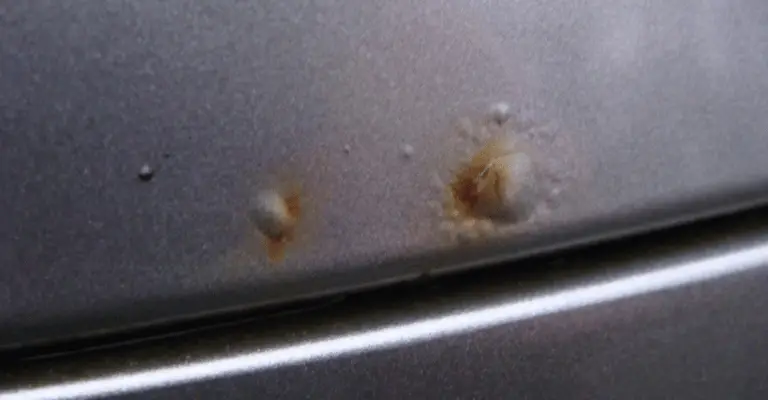The excitement of driving a car shiny with a fresh paint job can quickly curdle if you spot bubbles in the paintwork. It’s a dreaded sight for any vehicle owner, indicating trouble beneath the surface.
In this comprehensive guide, we dive under the layers of gloss to reveal the common culprits behind paint bubbling and map out a clear action plan.
With the knowledge and solutions we share, you won’t be left floundering when faced with this automotive woe. Instead, transform your panic into power, act promptly and protect your prized possession. Buckle up and get ready to combat car paint bubbling effectively!
What Causes Bubbling Car Paint?
The main culprit behind the formation of bubbles in car paint, also known as osmotic blistering, is moisture intrusion during the painting process. The moisture gets trapped beneath the paint’s surface or within it and then migrates to the surface, where it releases, creating a bubble or blister-like appearance.
Several conditions can trigger this bubbling effect:
- Painting was done under high temperature and humidity.
- Excessive paint was applied prematurely, trapping moisture and solvents.
- The drying process took too long, leading to trapped moisture or debris.
- The paint was stripped off, leaving the stainless steel exposed for a few hours, during which moisture and debris accumulated on it before the new paint was applied.
- Use of low-quality paint thinner.
- The undercoat wasn’t allowed to fully dry before the application of the topcoat.
For the trapped moisture to escape, the humidity level needs to drop while the outdoor temperature should rise. If the temperature dips too low, the moisture freezes within the paint, causing potential adhesion issues. Both scenarios can result in the formation of blisters or bubbles under the right conditions.
Related read: How To Protect Car Paint
Is It Rust?
Corrosion is another significant factor leading to paint bubbling and adhesion problems. Both moisture and exposed underlying metal play equal parts in this occurrence. The exposed metal could be as small as a chip from a stone or as large as a dent from a minor accident. In both instances, the exposed metal provides a pathway for moisture to reach the steel, triggering a chemical reaction, resulting in rust.
One differentiating factor is that moisture trapped in the paint can cause the entire surface of your vehicle to blister or bubble.

When Is It Not Rust?
The application speed can also lead to a bubbling effect. Unlike rust or moisture, this results in what looks like pinholes or craters. If too much paint is added too quickly or if the application is done from too close, it traps solvents or creates air pockets. The solvents eventually rise to the outer layer, while the air bubbles burst, leaving a crater-like texture.
De-lamination is another possible cause. This happens when the clear coat and underlying paint begin to disintegrate due to prolonged sun exposure. The paint begins to peel and bubble before it eventually flakes off.
How To Fix Bubbling Car Paint
Fixing bubbling car paint demands a certain level of expertise, a few tools, and some patience. Here’s a step by step guide on how to do it:
- Scrape off the bubbling paint: Use a putty knife or a similar tool to scrape off the bubbling paint.
- Remove rust and smooth the area: Use medium-grit sandpaper to remove any rust and smoothen the area.
- Clean the surface: Wipe the surface clean, dampen the area with mineral spirits, and let it dry.
- Apply primer: Apply one or two coats of primer and allow it to dry.
- Apply body filler: Use a body filler to level the area and let it dry until it hardens.
- Smoothen the filler: Use sandpaper to smoothen the filler and wipe it clean.
- Apply touch-up paint: Apply touch-up paint until it blends with the existing paint.
How To Prevent Car Paint Bubbling
Preventing car paint from bubbling involves taking some precautionary measures during the painting process. Here are some tips:
- Avoid painting under hot and humid conditions.
- Don’t apply too much paint too quickly.
- Allow sufficient drying time to prevent trapping moisture or debris.
- Ensure the undercoat is fully dry before applying the topcoat.
- Use a high-quality paint thinner.
- Avoid leaving the vehicle’s panel bare for a long time after stripping off the old paint.
Related Questions
Why Does My Car Paint Bubble After Rain?
Rainwater contains contaminants that can damage your car’s paint, especially if the surface is already compromised. If your car’s paint bubbles after rain, it could be due to moisture seeping into the paint layers and causing blistering.
Are Paint Blisters and Bubbles The Same Thing?
Yes, paint blisters and bubbles refer to the same phenomenon. They occur when a pocket of fluid, usually moisture, gets trapped between the layers of paint and then expands, forming bubbles or blisters that can eventually break open, leaving holes and damaged paint surfaces.
What Causes Paint Blisters On A Car?
Paint blisters on a car can be caused by several factors, including high levels of atmospheric humidity, the presence of water-soluble materials on the surface before painting, or such materials being absorbed into the paint film.
How Can I Repair Paint Blisters On My Car?
Repairing paint blisters on your car involves a similar process to that of fixing bubbling paint. The steps include scraping off the blistered paint, removing any rust, cleaning and drying the area, applying primer and body filler, sanding it down, and finally applying touch-up paint.
In conclusion, understanding the causes of car paint bubbling and how to fix and prevent it can help you maintain the aesthetic appeal of your vehicle. However, always remember that if you’re not confident in your painting skills, it’s better to hire a professional to avoid further damage.